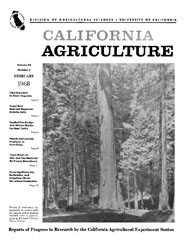|
|||
|
|||

Results of understory manipulation to reduce wildfire hazards and to improve
aesthetic value oj giant sequoia at Whitaker’s Forest, Tulare County.
February 1968
Volume 22, Number 2 |
|||
|
University of California, 1301 S. 46th St., Bldg. 478 Richmond, CA
|